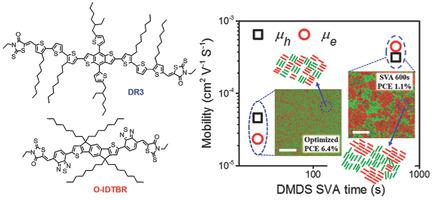当前位置:
X-MOL 学术
›
Adv. Energy Mater.
›
论文详情
Our official English website, www.x-mol.net, welcomes your feedback! (Note: you will need to create a separate account there.)
Carrier Transport and Recombination in Efficient “All‐Small‐Molecule” Solar Cells with the Nonfullerene Acceptor IDTBR
Advanced Energy Materials ( IF 27.8 ) Pub Date : 2018-04-03 , DOI: 10.1002/aenm.201800264 Ru‐Ze Liang 1 , Maxime Babics 1 , Victoria Savikhin 2, 3 , Weimin Zhang 1 , Vincent M. Le Corre 1 , Sergei Lopatin 4 , Zhipeng Kan 1 , Yuliar Firdaus 1 , Shengjian Liu 1 , Iain McCulloch 1 , Michael F. Toney 3 , Pierre M. Beaujuge 1
Advanced Energy Materials ( IF 27.8 ) Pub Date : 2018-04-03 , DOI: 10.1002/aenm.201800264 Ru‐Ze Liang 1 , Maxime Babics 1 , Victoria Savikhin 2, 3 , Weimin Zhang 1 , Vincent M. Le Corre 1 , Sergei Lopatin 4 , Zhipeng Kan 1 , Yuliar Firdaus 1 , Shengjian Liu 1 , Iain McCulloch 1 , Michael F. Toney 3 , Pierre M. Beaujuge 1
Affiliation

|
Reaching device efficiencies that can rival those of polymer‐fullerene Bulk Heterojunction (BHJ) solar cells (>10%) remains challenging with the “All‐Small‐Molecule” (All‐SM) approach, in part because of (i) the morphological limitations that prevail in the absence of polymer and (ii) the difficulty to raise and balance out carrier mobilities across the active layer. In this report, the authors show that blends of the SM donor DR3TBDTT (DR3) and the nonfullerene SM acceptor O‐IDTBR are conducive to “All‐SM” BHJ solar cells with high open‐circuit voltages (VOC) >1.1 V and PCEs as high as 6.4% (avg. 6.1%) when the active layers are subjected to a post‐processing solvent vapor‐annealing (SVA) step with dimethyl disulfide (DMDS). Combining electron energy loss spectroscopy (EELS) analyses and systematic carrier recombination examinations, the authors show that SVA treatments with DMDS play a determining role in improving charge transport and reducing non‐geminate recombination for the DR3:O‐IDTBR system. Correlating the experimental results and device simulations, it is found that substantially higher BHJ solar cell efficiencies of >12% can be achieved if the IQE and carrier mobilities of the active layer are increased to >85% and >10−4 cm2 V−1 s−1, respectively, while suppressing the recombination rate constant k to <10−12 cm3 s−1.
中文翻译:

带有非富勒烯受体IDTBR的高效“全小分子”太阳能电池中的载流子传输和复合
使用“全小分子”(All-SM)方法,可以达到可与聚合物-富勒烯本体异质结(BHJ)太阳能电池(> 10%)媲美的设备效率仍然具有挑战性,部分原因是(i)形态在没有聚合物的情况下存在的局限性;(ii)难以提高和平衡整个活性层上的载流子迁移率。在此报告中,作者表明,SM供体DR3TBDTT(DR3)和非富勒烯SM受体O-IDTBR的混合物有助于形成具有高开路电压(V OC)的“ All-SM” BHJ太阳能电池。)> 1.1 V且当有源层经过二硫化二甲基(DMDS)的溶剂蒸汽退火(SVA)后处理时,PCE高达6.4%(平均6.1%)。结合电子能量损失谱(EELS)分析和系统的载流子复合检查,作者表明DMDS的SVA处理在改善电荷传输和减少DR3:O-IDTBR系统的非gege重组方面起着决定性的作用。相关的实验结果和模拟装置,它被发现的> 12%的显着更高的BHJ的太阳能电池效率,可以实现如果有源层的IQE和载流子迁移增加至> 85%和> 10 -4厘米2 V - 1秒-1分别将重组率常数k抑制为<10 -12 cm 3 s -1。
更新日期:2018-04-03
中文翻译:

带有非富勒烯受体IDTBR的高效“全小分子”太阳能电池中的载流子传输和复合
使用“全小分子”(All-SM)方法,可以达到可与聚合物-富勒烯本体异质结(BHJ)太阳能电池(> 10%)媲美的设备效率仍然具有挑战性,部分原因是(i)形态在没有聚合物的情况下存在的局限性;(ii)难以提高和平衡整个活性层上的载流子迁移率。在此报告中,作者表明,SM供体DR3TBDTT(DR3)和非富勒烯SM受体O-IDTBR的混合物有助于形成具有高开路电压(V OC)的“ All-SM” BHJ太阳能电池。)> 1.1 V且当有源层经过二硫化二甲基(DMDS)的溶剂蒸汽退火(SVA)后处理时,PCE高达6.4%(平均6.1%)。结合电子能量损失谱(EELS)分析和系统的载流子复合检查,作者表明DMDS的SVA处理在改善电荷传输和减少DR3:O-IDTBR系统的非gege重组方面起着决定性的作用。相关的实验结果和模拟装置,它被发现的> 12%的显着更高的BHJ的太阳能电池效率,可以实现如果有源层的IQE和载流子迁移增加至> 85%和> 10 -4厘米2 V - 1秒-1分别将重组率常数k抑制为<10 -12 cm 3 s -1。


























 京公网安备 11010802027423号
京公网安备 11010802027423号